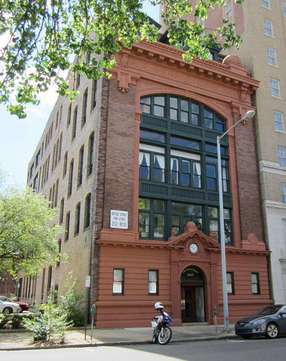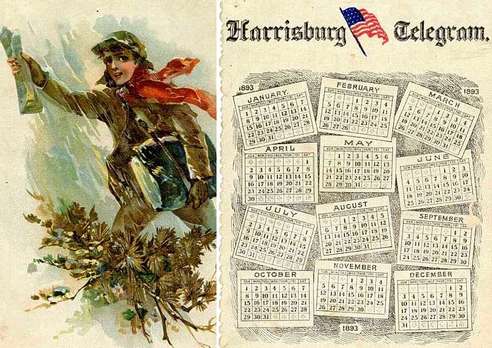Fenton's Birmingham Age Herald. Based on our original research and an Article we wrote in 2013. With thanks to Mike Brown.
It’s an intriguing combination: a magnificent piece of Carnival Glass featuring a detailed portrayal of a building’s façade. The script lettering above reads “Birmingham Age Herald” and at the bottom “Carriers Greetings” with the date, 1911.
What is The Story Behind the Glass?
What are the reasons for the building being featured, and what exactly are “Carriers Greetings”? Let’s begin with the story behind the building itself, as it is the most prominent feature on this beautiful piece of Carnival Glass.
|
The splendid, five storey structure (at 2107 5th Avenue N, Birmingham, Alabama) is on the USA’s National Register of Historic Places. Its date of construction is debatable, as certain sources state that it was built in 1920, however the 1911 date on the Carnival Glass items clearly show that it was much earlier! The building still stands, housing various offices such as law firms. What of the Birmingham Age Herald newspaper itself? With its roots back in 1850, it had various names over the years, but in 1888 it acquired the name Birmingham Age Herald through a merger between The Daily Birmingham Age and The News Herald. The paper continued in one form or another until it became the Post Herald in 1950 following a merger. Although the newspaper closed in 2005, the structure still stands, the name AGE HERALD BUILDING clearly showing at the top of the façade, where it is carved into the stonework. |
The Age Herald Building on 5th Avenue, Birmingham, AL. Courtesy “Moto Guzzi”.
|
Detail from Fenton's moulded image
of the building's frontage |
What now of the phrase “Carriers Greetings” at the bottom of the piece?
Who were the Carriers? And what were their greetings? And how does all of this tie up with Carnival Glass? Let’s try and unravel the story.
Carriers Greetings was also formerly known as Carriers’ Address, and “Carriers” was another name for newspaper boys – the lads (often very young) who either delivered the newspapers or stood on busy street corners selling them.
|
The idea of giving delivery boys a tip at that time of the year has its roots in the Boxing Day tradition of the UK and apparently the custom then spread to the USA during the Colonial era. Above: The Dec 24th. 1914 edition of the Hopkinsville Kentuckian.
Gilmer Pursley, Carter King and Elvin Riggins were the young boys hoping to receive their Christmas rewards for delivering newspaper throughout 1914! |
Above: From the early days of Carriers Greetings, this Christmas 1892
offering gave customers a printed 1893 calendar |
|
At Christmas time and New Year, the boys would be given printed sheets of illustrated poems or calendars, to hand out to their customers, with the unspoken expectation of a tip or reward in return - the Carriers Greetings. The poems were often very sentimental, and clearly intended to touch the heart strings (and the purse strings) of their recipients. The snippet on the left which ends one of the Carriers’ Greetings sums it up perfectly. You can almost see a palm outstretched as you read it! |
The Glass: Fenton’s Birmingham Age Herald
The Birmingham Age Herald items are part of a desirable style of Carnival Glass known loosely as Advertising Pieces. These are usually found in the form of plates and bowls featuring floral or (rarely) buildings and lettering that pertain to a business. They were undoubtedly produced as incentives (“premiums”) or free give-aways to promote the business or concern that they were advertising. The main producers of these items were Fenton, Northwood and Millersburg.
The Birmingham Age Herald pieces are known in one colour only – amethyst - and in the two basic shapes of approx. 9” to 9.5” plate and approx. 8” to 9” bowl. The Wide Panel back pattern confirms the maker as Fenton, despite early opinions suggesting they were made by Millersburg.
They are scarce and undoubtedly sought-after pieces in any shape, although it seems that the plates are a little easier to source. The bowls are known to be ice cream shaped or to have six ruffles; a rare hand grip plate is known as well as the regular flat plates. The simple bowl form would have been the “as moulded” shape and the plate would have then been “spun” from the bowl shape. The plunger that was made for these items bears the design of the Age Herald’s 5th Avenue façade, with the script lettering above and below, plus that all important feature, the date, 1911. The mouldwork is detailed and very accurately portrays the façade, even including the owls that stand either side of the lettering marking the name of the building.
Birmingham Age Herald, by Fenton. On the left, a plate and on the right a ruffled bowl, both in amethyst. Both courtesy of Seeck Auctions
The question left hanging in the air - why did the Birmingham Age Herald newspaper go against the tradition of producing Carriers’ Greetings in the form of a cheap printed give-away, and instead invest in the production of a customised glass souvenir?
As we’ve seen, Carriers’ Greetings were usually distributed to the customers by the news delivery boys, along with the papers themselves. A small paper pamphlet would have been very light and easy to slip inside the pages of the newspaper. But a large glass plate? Surely the delivery boys didn’t have to take one of these to every customer? They’d have needed a horse and cart to make the deliveries! Our theory is that the Carnival plates (and bowls) were surely presented as promotional gifts to specially selected, major customers such as the advertisers who brought in repeat business, large stores, businesses and other big clients. It’s likely that the newspaper’s salesmen took them out: can you just imagine them handing over a fabulous plate with the words … “thank you for your business through 1910 and we hope you’ll remain with us in 1911”?
Another slightly puzzling aspect is why a newspaper in Alabama would have approached a company that was located seven hundred miles away to produce a promotional gift item for them? Obviously, they weren’t able to simply “google” Fenton and come up with a great deal, so how did it all come about? Our feeling is that the initial impetus probably came from Fenton themselves - it seems likely that they sought out customers for their promotional gift lines (i.e. what we call the Advertising Pieces). It’s unlikely the glass items were cheap to produce though, as the cost of a unique metal plunger (which carried the main design) had to be factored in. And what did Fenton use when their mould maker created the design of the Age Herald building? A photo of the façade perhaps? Or was it based on an artist’s sketch?
There’s no doubt that the story behind the Birmingham Age Herald Carnival Glass items is a fascinating and enigmatic one.
Read more of The Stories Behind The Glass in Carnival Glass Times









